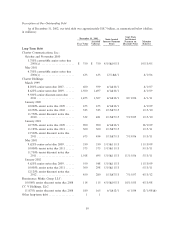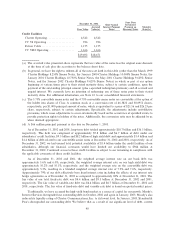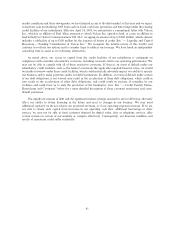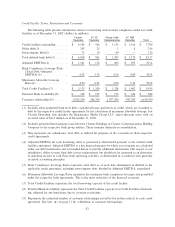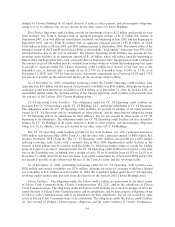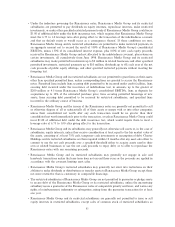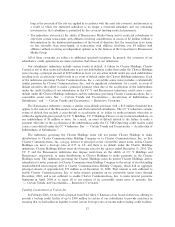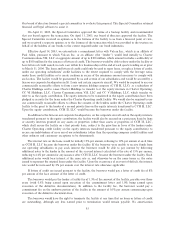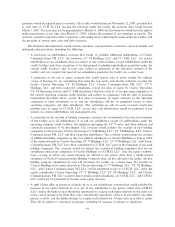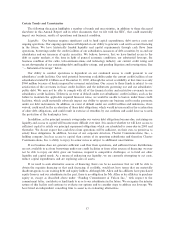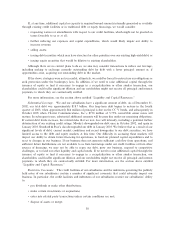Charter 2002 Annual Report Download - page 50
Download and view the complete annual report
Please find page 50 of the 2002 Charter annual report below. You can navigate through the pages in the report by either clicking on the pages listed below, or by using the keyword search tool below to find specific information within the annual report.Generally, under Charter Holdings' high yield indentures:
‚ Charter Holdings and its restricted subsidiaries are generally permitted to pay dividends on equity
interests, repurchase interests, or make other speciÑed restricted payments only if Charter Holdings
can incur $1.00 of new debt under the leverage ratio test, which requires that Charter Holdings meet an
8.75 to 1.0 leverage ratio after giving pro forma eÅect to the transaction and that no default exists or
would exist as a consequence of such incurrence. If those conditions are met, restricted payments in an
aggregate amount of up to 100% of Charter Holding's consolidated EBITDA, minus 1.2 times its
consolidated interest expense, plus 100% of new cash and non-cash equity proceeds received by
Charter Holdings and not allocated to the debt incurrence covenant or to permitted investments, all
cumulatively from March 1999, the date of our Ñrst indenture, plus $100 million. Charter Holdings'
restricted subsidiaries include virtually all of its direct and indirect subsidiaries.
‚ Charter Holdings and its restricted subsidiaries may not make investments except permitted invest-
ments if there is a default under the indentures or if Charter Holdings' could incur $1.00 of new debt
under the leverage ratio test described above after giving eÅect to the transaction. Permitted
investments include investments by Charter Holdings in restricted subsidiaries or by restricted
subsidiaries in Charter Holdings, investments in productive assets (including through equity) up to
$150 million, investments aggregating up to 100% of new cash equity proceeds received by Charter
Holdings since March 1999 and not allocated to the debt incurrence or restricted payments covenant,
and other investments up to $50 million.
‚ Charter Holdings is not permitted to grant liens on its assets other than speciÑed permitted liens.
Permitted liens include liens securing debt and other obligations incurred under our subsidiaries' credit
facilities, liens securing the purchase price of new assets, other liens securing indebtedness up to
$50 million and speciÑed liens incurred in the ordinary course of business.
‚ Charter Holdings and Charter Capital, its co-issuer, are generally not permitted to sell all or
substantially all of their assets or merge with or into other companies unless their leverage ratio after
any such transaction would be no greater than their leverage ratio immediately prior to the transaction,
or unless Charter Holdings and its subsidiaries could incur $1.00 of new debt under the debt incurrence
test described above after giving eÅect to the transaction.
‚ Charter Holdings and its restricted subsidiaries may generally not otherwise sell assets or, in the case of
restricted subsidiaries, issue equity interests, unless they receive consideration at least equal to the fair
market value of the assets or equity interests, consisting of at least 75% in cash, assumption of
liabilities, securities converted into cash within 60 days or productive assets. Charter Holdings and its
restricted subsidiaries are then required within 365 days after any asset sale either to commit to use the
net cash proceeds over a speciÑed threshold to acquire assets, including current assets, used or useful in
their businesses or use the net cash proceeds to repay debt, or to oÅer to repurchase the Charter
Holdings notes with any remaining proceeds.
‚ Charter Holdings and its restricted subsidiaries may not engage in sale and leaseback transactions
unless, at the time of the transaction, Charter Holdings could have incurred secured indebtedness in an
amount equal to the present value of the net rental payments to be made under the lease, and the sale
of the assets and application of proceeds is permitted by the covenant restricting asset sales.
‚ Charter Holdings' restricted subsidiaries may not enter into restrictions on their ability to make
dividends or distributions or transfer assets to Charter Holdings on terms that are materially more
restrictive than those governing their debt, lien, asset sale, lease and similar agreements existing when
they entered into the indentures, unless those restrictions are on customary terms that will not
materially impair Charter Holdings' ability to repay the high yield notes.
‚ The restricted subsidiaries of Charter Holdings are generally not permitted to guarantee or pledge
assets to secure debt of Charter Holdings, unless the guarantying subsidiary issues a guarantee of the
notes of comparable priority and tenor, and waives any rights of reimbursement, indemnity or
subrogation arising from the guarantee transaction for at least one year.
48



